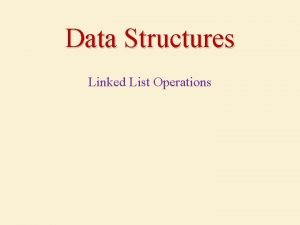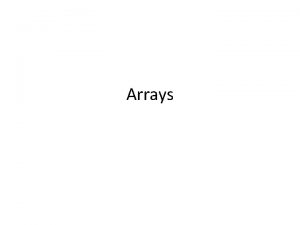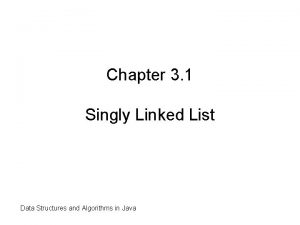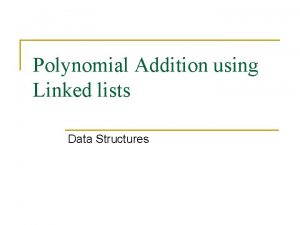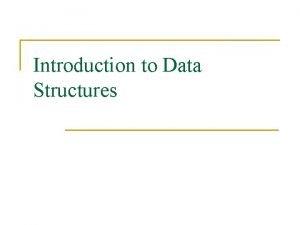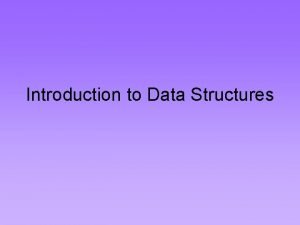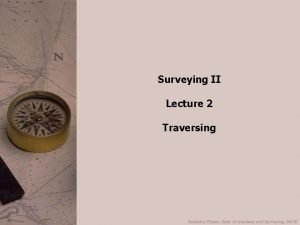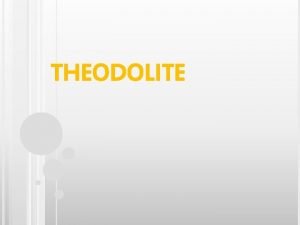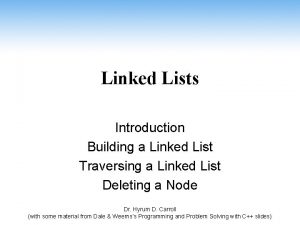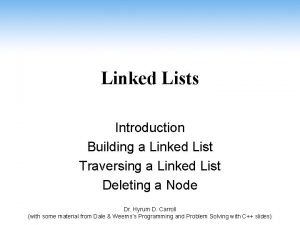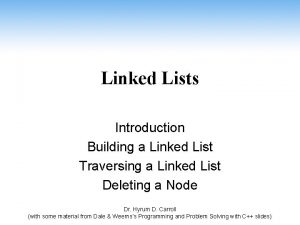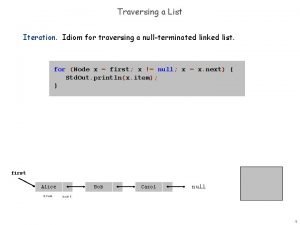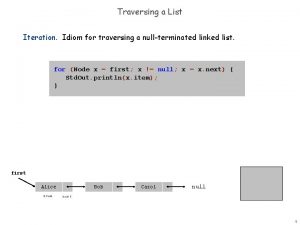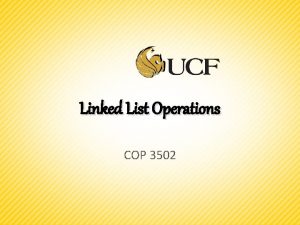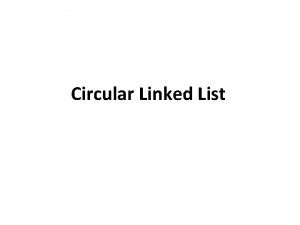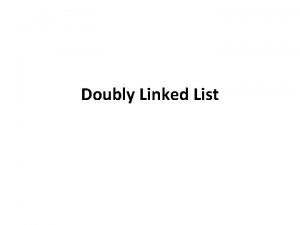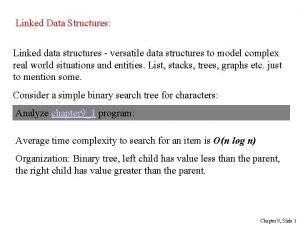Data Structures Linked List Operations Outlines Introduction Traversing
















- Slides: 16

Data Structures Linked List Operations

Outlines • • • Introduction Traversing a Linked List Searching a Linked List Memory Allocation & Garbage Collection Overflow and Underflow Review Questions

Introduction • A linked list (One-way list) is a linear collection of data elements, called nodes, where the linear order is given by means of pointers. • Each node is divided into two parts. • First part contains the information of the element. • Second part contains the address of the next node in the list.

Traversing a Linked List • • PTR is a pointer variable which points to the node currently being processed. LINK [PTR] points to the next node to be processed. q Algorithm (Traversing a linked list) 1. Set PTR = START. [Initialize pointer PTR] 2. Repeat step 3 and 4 while PTR ≠ NULL. 3. Apply PROCESS to INFO[PTR]. 4. Set PTR = LINK [PTR]. [PTR points to next node] [End of Step 2 Loop. ] 5. EXIT

Problems • Write an algorithm to modify each element of an integer linked list such that (a) each element is double of its original value. (b) each element is sum of its original value and its previous element. • Write an algorithm to find out the maximum and minimum data element from an integer linked list.

Searching a Linked List

Searching a Linked List (1) q List is Unsorted SEARCH (INFO, LINK, START, ITEM, LOC) 1. Set PTR = START. 2. Repeat Step 3 While PTR ≠ NULL. 3. If ITEM = INFO [PTR], then: Set LOC = PTR, and EXIT. Else: Set PTR = LINK [PTR]. [PTR points to next node] [End of if Structure. ] [End of step 2 Loop. ] 4. Set LOC = NULL. [Search is Unsuccessful. ] 5. Exit. [Return LOC and Exit. ]

Searching a Linked List (2) q List is Sorted SEARCH (INFO, LINK, START, ITEM, LOC) 1. Set PTR = START. 2. Repeat Step 3 While PTR ≠ NULL. 3. If ITEM > INFO [PTR], then: PTR = LINK [PTR]. [PTR points to next node] Else if ITEM = INFO [PTR], then: Set LOC = PTR, and EXIT. [Search is successful. ] Else: Set LOC = NULL, and EXIT. [ITEM exceeds INFO[PTR]…] [End of if Structure. ] [End of step 2 Loop. ] 4. Return LOC. 5. Exit.

Memory Allocation • Together with the linked list, a special list is maintained which consists of unused memory cells. • This list has its own pointer. • This list is called List of available space or Free-storage list or Free pool.

Free Pool • Linked list with free pool or list of Available space. INFO START 2 1 2 3 AVAIL 10 5 6 7 8 9 10 LINK 0 A 6 E 9 C 4 7 8 B 4 D 3 1 F 0 5

Garbage Collection • Garbage collection is a technique of collecting all the deleted spaces or unused spaces in memory. • The OS of a computer may periodically collect all the deleted space onto the free-storage list. • Garbage collection may take place when there is only some minimum amount of space or no space is left in free storage list. • Garbage collection is invisible to the programmer.

Garbage Collection Process • Garbage collection takes place in two steps. 1. The computer runs through all lists tagging those cells which are currently in use. 2. Then computer runs through the memory, collecting all the untagged spaces onto the free storage list.

Overflow and Underflow q Overflow: When a new data are to be inserted into a data structure but there is no available space i. e. the free storage list is empty. • Overflow occurs when AVAIL = NULL, and we want insert an element. • Overflow can be handled by printing the ‘OVERFLOW’ message and/or by adding space to the underlying data structure.

Overflow and Underflow q Underflow: When a data item is to be deleted from an empty data structure. • Underflow occurs when START = NULL, and we want to delete an element. • Underflow can be handled by printing the ‘UNDERFLOW’ message.


Review Questions • Write an algorithm to find out the maximum and minimum data element from an integer linked list. • What is the condition of Overflow and underflow? • What are the steps followed during garbage collection?
 Traversing a linked list
Traversing a linked list Singly linked list vs doubly linked list
Singly linked list vs doubly linked list Singly vs doubly linked list
Singly vs doubly linked list Single linked list adalah yang paling dari semua varian
Single linked list adalah yang paling dari semua varian Traversing array algorithm
Traversing array algorithm Java data structures
Java data structures Linked list polynomial addition
Linked list polynomial addition Polynomial addition using linked list
Polynomial addition using linked list Introduction to data structures
Introduction to data structures Introduction to data structures
Introduction to data structures Principle of traverse
Principle of traverse Local attraction in compass surveying
Local attraction in compass surveying Purpose of theodolite
Purpose of theodolite Engineering survey 1
Engineering survey 1 Root leaf
Root leaf Axis method of balancing traverse
Axis method of balancing traverse Homologous structures and analogous structures
Homologous structures and analogous structures
